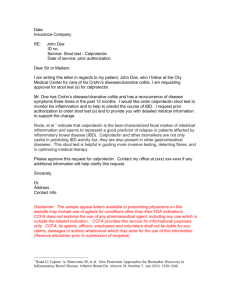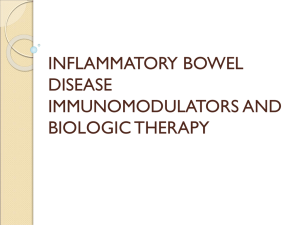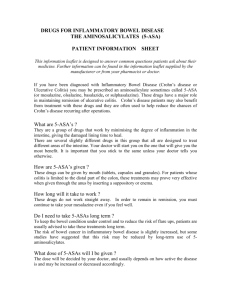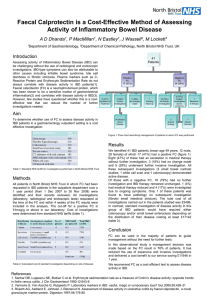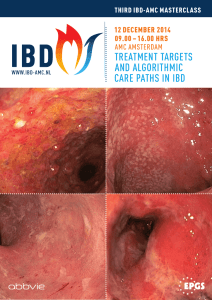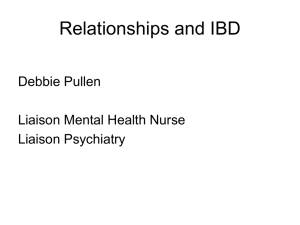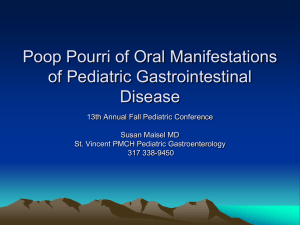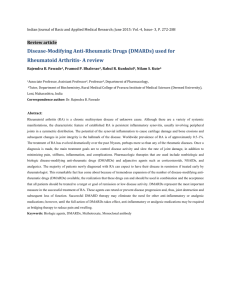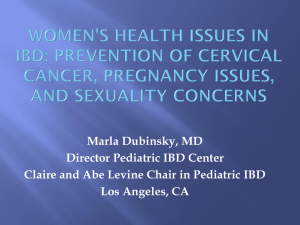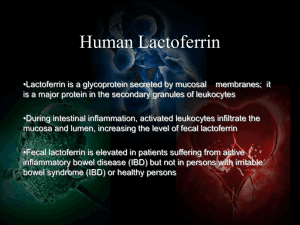Inflammatory Bowel Disease
advertisement
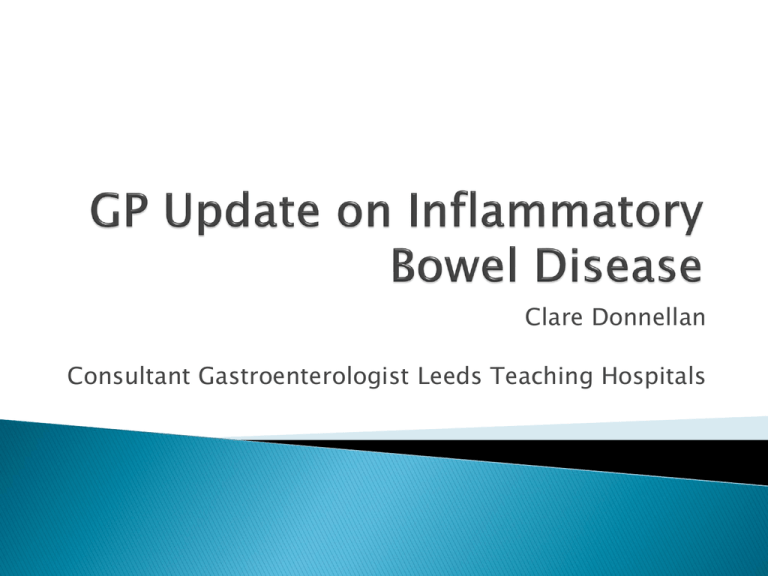
Clare Donnellan Consultant Gastroenterologist Leeds Teaching Hospitals Key features of IBD History & examination Investigations Treatment including DMARDs Flares – what should GPs do? What’s new? Incidence UC 10 per 100,000 Incidence CD 6-7 per 100,000 Prevalence 400 per 100,000 (250/150) Onset between 15 and 40 years of age Similar in males and females Ulcerative colitis ◦ Proctitis ◦ Left-sided disease ◦ Pan-colitis Crohn’s Disease ◦ Affects anywhere Small bowel (80%) Small & Large bowel (50%) Peri-anal disease (35%) More likely to get complications IBD-unclassified 5% Genetics ◦ 10-25% of patients have at least one other family member affected ◦ No particular gene identified in UC ◦ NOD2/CARD15 gene abnormalities in CD Terminal ileal disease Possibly more chance of requiring surgery Environmental factors ◦ Smoking Protective for UC Worsens outcome for CD ◦ Appendicectomy Protective for UC Unlikely effect for CD ◦ Diet? ◦ Bacteria? Episcleritis/scleritis ◦ 2 to 5% of patients ◦ Activity linked to GI tract Anterior uveitis ◦ ◦ ◦ ◦ 0.5-3%, but much more serious Females:males 4:1 75% of patients have arthritis Activity not linked to GI tract Erythema nodosum ◦ Most common skin manifestation of IBD (up to 15%) ◦ Typically flares at same time as GI symptoms Pyoderma grangrenosum ◦ Up to 5% of patients ◦ More chronic course Related to GI activity ◦ Peripheral arthritis ◦ Episcleritis/scleritis ◦ Erythema nodosum Not related to GI activity ◦ Spondylitis/sacroiliitis ◦ Anterior uveitis ◦ Pyoderma Gangrenosum Bloody diarrhoea or prolonged diarrhoea (-ve MC&S) ◦ Abdominal pain ◦ Urgency ◦ Tenesmus If 1st presentation ◦ ◦ ◦ ◦ ◦ Stool frequency/day & night ◦ Travel Systemic features ◦ DH (Abx, NSAIDs Weight loss ◦ FH Fever ◦ SH Extra-GI features ‘The professional patient’ ◦ Is it like a ‘usual’ flare? ◦ What are the usual strategies? ◦ IBD Helpline 0113 206 8679 Is it severe? ◦ Truelove and Witts criteria ≥6 bloody stools per day Systemic toxicity (HR>90, T>37.8, ESR>30) or Hb<10.5 NEEDS ADMITTING for IV steroids Much more challenging to ΔΔ IBD vs. IBS…. ◦ ◦ ◦ ◦ ◦ Abdominal pain Diarrhoea (ask re: nocturnal symptoms) Weight loss Systemic features Extra-GI manifestations ‘The professional patient’ ◦ Is it like a ‘usual’ flare? ◦ What are the usual strategies? ◦ IBD Helpline 0113 206 8679 Systemically unwell? ◦ Fever ◦ Tachycardia Dehydration BMI/weight Abdominal tenderness/distension/bowel sounds Palpable mass Peri-anal examination Follow ‘usual’ strategy Call helpline (pt or GP) if concerned ◦ Advice ◦ Early access to IBD clinic Admit if systemically unwell FBC, U&E, LFT, CRP Haematinics Stool MC&S Stool C diff (Stool OC&P) Urgent referral to gastroenterology if high index of suspicion UC ◦ ◦ ◦ ◦ ◦ ◦ Bloods AXR Urgent stool cultures Urgent flexible sigmoidoscopy within 24 hours (CMV PCR and CMV on biopsies) CT if risk of perforation Crohn’s ◦ Varies on symptoms/distribution ◦ Low threshold for CT abdo/pelvis ◦ Flexible sigmoidoscopy often unhelpful ◦ MR pelvic if abscess/fistulising disease Small bowel ◦ ◦ ◦ ◦ ◦ ◦ Small bowel meal if suspected CD/suspected SB CD MR enterography (enteroclysis) if known SB CD OGD Ultrasound Wireless capsule endoscopy Isotope (labelled white cell scans) Colon ◦ Colonoscopy ◦ CT colonography 5-ASAs ◦ Prescribe by drug name ◦ But lower cost equivalents (Asacol = Mesren = Octasa) ◦ Dose Asacol 2.4 g vs. 4.8 g Minimum 2 g for maintenance (1.2 g cancer prevention) ◦ OD as effective and better adherence for maintenance ◦ Tablets + Local therapy often avoids steroids 5-ASA enemas better than steroid enemas DMARDs ◦ Azathioprine 2-2.5 mg/kg ◦ 6-mercaptopurine 1-1.5 mg/kg ◦ Weekly bloods for 4/52 ◦ Then monthly ◦ Then 3 monthly ◦ S/E (Raised MCV and lymphopaenia) Other DMARDs ◦ Methotrexate Evidence not great ◦ Mycophenolate Some evidence Optimise 5-ASAs first if sole treatment ◦ Maximise dose ◦ Add in local therapy (5-ASAs, not steroids) Prednisolone 30 mg daily with Ca/Vit D cover ◦ More prolonged course If not settling (or severe UC) IV steroids Is it severe? ◦ Truelove and Witts criteria ≥6 bloody stools per day Systemic toxicity (HR>90, T>37.8, ESR>30) or Hb<10.5 NEEDS ADMITTING for IV steroids Colectomy rate approx. 30% Day 3 (Travis criteria) ◦ If stool frequency > 8 or CRP > 45 ◦ 85% chance of colectomy 3 options ◦ Surgery ◦ Infliximab ◦ Cyclosporin as a bridge to Aza/6-MP Ciclosporin/infliximab ◦ 70 – 80% leave hospital with colon ◦ 30% long-term Infection risks No role for 5-ASAs except if mild colitis ? Role after surgery in preventing relapse If luminal disease ◦ Oral steroids ◦ IV steroids if no response ◦ Still no response? No role for ciclosporin Give infliximab +/- azathioprine for 1 year ◦ Nutrition support key If peri-anal disease ◦ Drain any sepsis ◦ Antibiotics ◦ Seton sutures ◦ Escalate therapy as appropriate DMARDS ◦ ◦ ◦ ◦ Azathioprine Methotrexate (s/c) Mycophenolate Tacrolimus Surgery ◦ For complications Biologicals ◦ Infliximab ◦ Adalimumab (Humiara) ◦ NICE assessment at 1 yr Liquid diet for Crohn’s Bone protection Endoscopic dilatation of strictures Calprotectin ◦ Diagnosis ◦ Activity assessment Azathioprine metabolite levels ◦ Optimise dose ◦ Minimise side-effects ◦ ? Reduce number of patients needing biologicals Leucocytapheresis Mucosal healing Guided self-management More nurse-led clinics Reduce follow-up waits… Less ‘black and white’ in/out of service Significant morbidity Early, focused management Use helpline 0113 206 8679 Admit if systemically unwell Stool cultures Appropriate steroid course
